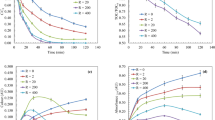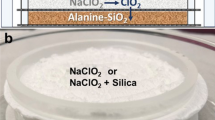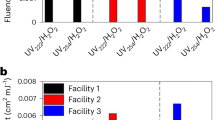Abstract
THE establishment of world-wide and varied uses of ‘Gramoxone’1 herbicide requires a complete understanding of the behaviour of its active constituent, paraquat, in all circumstances. The present report is concerned with the photochemical degradation of the chemical.
This is a preview of subscription content, access via your institution
Access options
Subscribe to this journal
Receive 51 print issues and online access
$199.00 per year
only $3.90 per issue
Buy this article
- Purchase on Springer Link
- Instant access to full article PDF
Prices may be subject to local taxes which are calculated during checkout
Similar content being viewed by others
References
Registered Trade Mark of Plant Protection, Ltd.
Smith, I., Chromatographic and Electrophoretic Techniques, 1, 396 (London: W. Heinemann Ltd., 1960).
Green, R. W., and Tong, H. K., J. Amer. Chem. Soc., 78, 4986 (1956).
Shaw, E. N., in The Chemistry of Heterocyclic Compounds: Pyridine and its Derivatives, Part 2, edit. by Klingsberg, E., 58 (New York: Interscience Publishers Inc., 1961).
Author information
Authors and Affiliations
Rights and permissions
About this article
Cite this article
SLADE, P. Photochemical Degradation of Paraquat. Nature 207, 515–516 (1965). https://doi.org/10.1038/207515a0
Published:
Issue Date:
DOI: https://doi.org/10.1038/207515a0
This article is cited by
-
Occurrence of 1,1′-dimethyl-4,4′-bipyridinium (Paraquat) in irrigated soil of the Lake Chad Basin, Niger
Environmental Science and Pollution Research (2014)
-
Utilization of the plant methionine sulfoxide reductase B genes as selectable markers in Arabidopsis and tomato transformation
Plant Cell, Tissue and Organ Culture (PCTOC) (2013)
-
The detection of paraquat (dichloride) in wood by pyrolysis vapour-phase chromatography
Wood Science and Technology (1979)
-
Microbiological transformation of pyridine derivatives (review)
Chemistry of Heterocyclic Compounds (1978)
-
Photochemistry of quaternary salts of aromatic heterocycles and some of their mesoionic derivatives (Review)
Chemistry of Heterocyclic Compounds (1974)
Comments
By submitting a comment you agree to abide by our Terms and Community Guidelines. If you find something abusive or that does not comply with our terms or guidelines please flag it as inappropriate.



